Dzibilchaltun Mayan Ruins - Everything you need to know!
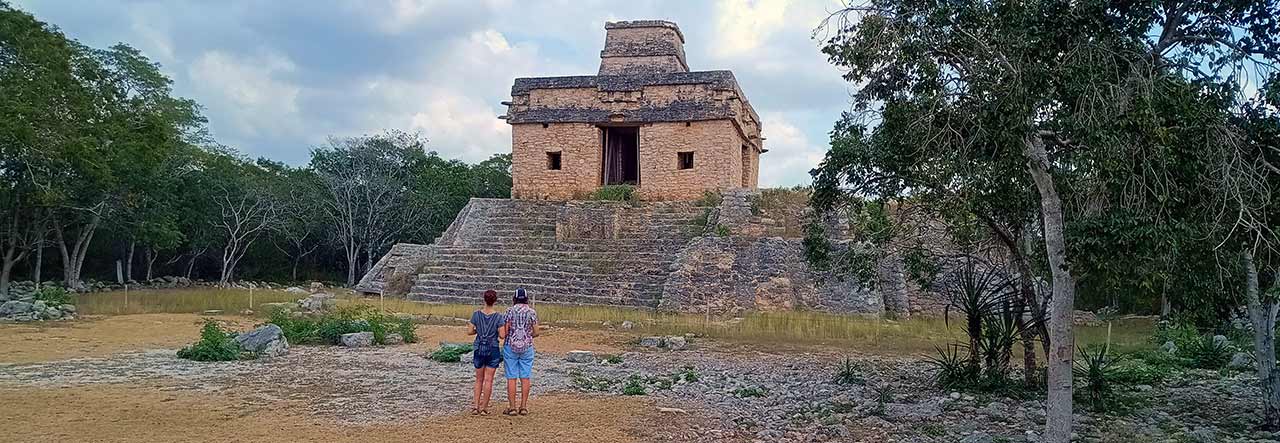
Chichen Itza and Uxmal are well-known Mayan archaeological sites, getting many visitors but other, less well-known sites also make a great day out. Among these are the Dzibilchaltun Mayan ruins, one of the largest cities of pre-Hispanic Mesoamerica anywhere.
Often overlooked, Dzibilchaltun Mayan ruins have many unique features and interesting buildings. It is one of the few Mayan ruins that has a Franciscan chapel in the middle!
It is close enough to Merida to make this a great day trip – or even just a fascinating morning. This is good news if you don’t want to spend a long time in a car or coach visiting Uxmal or Chichen Itza.
The new Mayan Train project should bring more tourists to enjoy the Dzibilchaltun archaeological site. As part of the Mayan Train project to boost tourism in the Yucatan, as of January 2024, some building work is underway in and around the entrance. This includes the museum which is currently closed and will be replaced by a new and larger museum. This work is only at the entrance and not at the archaeological site.
There are very few signs at the site to say what the various buildings are, either in Spanish or English. However, guides are waiting at the entrance to take you around, for a fee. I can’t vouch for any but we met one who speaks excellent English and is a part-time archaeologist.
How do you pronounce Dzibilchaltun? The pronunciation of Dzibilchaltun is something like – Tsee-beel-chahl-toon. I’ll be honest, I still can’t say it!
Visiting Dzibilchaltun Mayan ruins From Merida
The distance between Merida and Dzibilchaltun is short. It should take you less than 30 minutes from the Centro area of Merida (subject to traffic/ time of day). But a lot depends on where you are staying. We live just outside the Periferico or ring road and we can do the trip in 20 minutes.
Ideally, you should do the trip by car as it gives you the freedom to come and go as you please.
Taxis can be expensive when you add in the wait time. Using Uber is a good alternative. According to the Uber app (January 2024), an Uber to Dzibilchaltun will cost about MXN250 one way. That cost will vary during the day but it gives you an idea.
There are no direct buses from Merida to the Dzibilchaltun Mayan ruins.
Several companies in Merida offer tours of the Dzibilchaltun Mayan ruins and will arrange pick-up if you’re staying in one of the hotels in the general Centro area. They will also add in other stops to make a full day if you want.
For those arriving on cruise ships into Progreso, there are several tours available. As it’s only about 25 minutes from the pier at Progreso to Dzibilchaltun, this is a great opportunity to visit a Mayan ruins near Progreso without rushing!
And, if you’re visiting Dzibilchaltun from Merida, don’t forget you can easily carry onto Progreso to make a lovely day out.
How to Get to Dzibilchaltun from Merida or Progreso
These are the only Mayan ruins near Merida. So it’s no surprise the journey from Merida to Dzibilchaltun is straightforward. If you’re staying in Centro, use Waze or Google Maps to take you as quickly as possible to the Periférico. This should take 10 minutes or less. You can go north through the city but the traffic can be slow.
Once on the Periférico, take the directions north to Progreso. Once you’ve joined the Merida/Progreso highway (the 261) look for the sign to Dzibilchaltun. Make sure you are in the righthand lane as there is a long slip road. Follow the signs to Dzibilchaltun.
Once you’re in the town, which is very small, keep going. The road to the ruins is on the right just after you’ve gone round the bend leaving the town.
From Progreso, you simply drive south down the Merida/Progreso Highway (the 261) until you see the Dzibilchaltun signs.
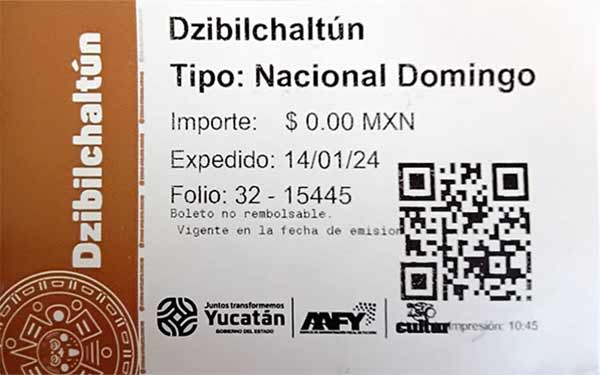
What is the cost of the Dzibilchaltun entrance fee
Like all Yucatan Mayan ruins, the costs are in two parts
Here is a link to the official website. For tourists, the Dzibilchaltun entrance fee is now MXN95 (for the INAH portion) and MXN213 (for the Government of the State of Yucatán portion), making MXN 308 in total.
If you are a Mexican citizen or are a foreign resident the Government fee is MXN86. That makes the total Dzibilchaltun entrance fee MXN181. (All fees are waived on Sundays for Mexicans and foreign residents.)
There’s only one gate to pay both fees, which should be paid in cash. You get a receipt and a card ticket. The invoice will be taken at the entrance. Then you need to scan the QR code on your card ticket to get in. Keep it! You need to scan it to leave.
The opening times are Monday to Sunday 8 am to 5 pm.
If you want to use a guide around the archaeological site, the cost as of January 2024 was MXN450 for a full tour.
What should I bring when visiting Dzibilchaltun Mayan Ruins?
Cash
It’s always wise to bring cash when you visit any Mayan ruins. You have to pay the entrance fee in cash. If you use a guide at Dzibilchaltun, they want cash. There are drink and food stalls at the entrance which take cash only.
Camera or phone
Bring your camera or phone. But do make sure your batteries are fully charged!
Mosquito Spray
Generally, the whole Dzibilchaltun site is in the open and bug-free. However, when I explored the areas covered by trees, especially near the cenote, several mosquitoes were buzzing around me. Back in the open, they disappeared again. Lesley, who is a mosquito magnet got bitten twice! So, you may want to take some mosquito spray to be on the safe side.
Sunscreen and a hat
The summers in the Yucatan are hot and the sun is strong. The Dzibilchaltun Mayan ruins cover a large area, with a lot of walking between buildings, especially on the way to the Temple of the Sun. It would be wise to bring strong sunscreen and a hat.
Water
It’s easy to get dehydrated when you’re walking about in the heat. It’s a good idea to take water bottles into Dzibilchaltun. You can buy drinks at the entrance.
Good footwear
It’s sensible to wear good footwear when visiting Dzibilchaltun. Not only does the archaeological site cover a large area, the terrain can be rocky. Even the main paths can have uneven rocks. After we had walked to the Temple of the Sun, we took the sandy path back that ran along the edge of the forest. This was kinder underfoot.
As you can climb almost everywhere, you run the risk of slipping or stumbling.
What are the restrictions when visiting Dzibilchaltun?
Unlike most Mayan Ruins, you can climb many of the buildings and structures. The areas you are forbidden from climbing are clearly marked and roped off.
- There were no signs prohibiting tripods when we were last there (January 2024).
- Like all archaeological zones in Mexico, you cannot use drones of any size at the Dzibilchaltun Mayan ruins.
- Backpacks are not allowed. There are lockers at the entrance where you can store them in while you are at the archaeological site.
- Smoking is prohibited.
- Food and drink are not allowed, except for water. We saw someone have a cup of coffee confiscated at the gate.
- Pets are not allowed.
And, oddly, musical instruments are not allowed! So, leave your guitar at the hotel or the ship!
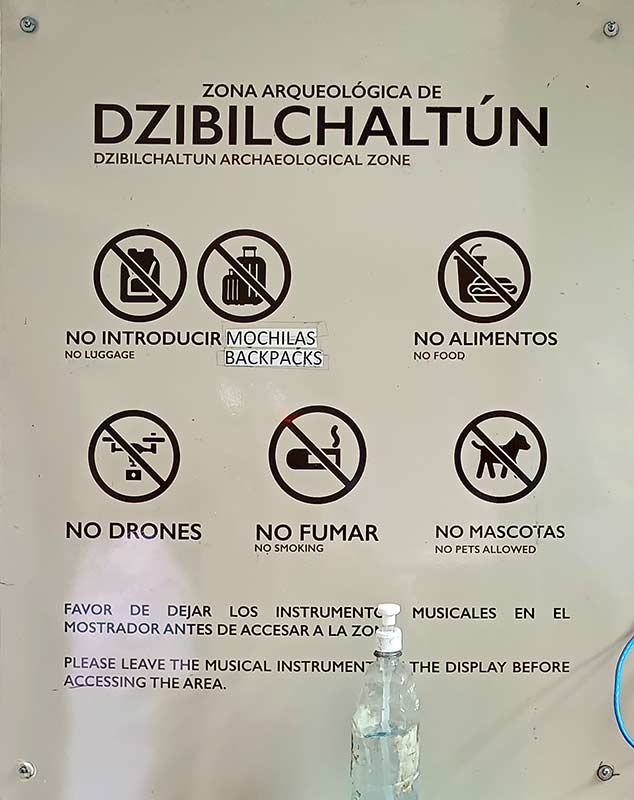
What’s the best time to visit the Dzibilchaltun Mayan ruins?
When’s the best season for visiting Dzibilchaltun?
The seasons in the Yucatan vary from year to year (like everywhere these days). As a general rule, April to September is hot, with April and May being the hottest, around 98f (37c). Normally June to October suffers the heaviest rain. The rain normally comes in heavy downpours. These typically only last a few hours and occur mainly in the late afternoon. The combination of heat and the rain results in high humidity which be uncomfortable for some.
January and February are normally the best months to visit! But visiting Dzibilchaltun from October through to March is normally ok as these months tend to be a bit cooler and drier.
What’s the best time of day for visiting Dzibilchaltun?
Dzibilchaltun doesn’t get the crowds suffered at the more well-known Mayan Ruins. Whether that will change with the Mayan Train is hard to say. I doubt it!
The days that cruise ships dock at Progreso are normally Tuesdays and Thursdays. A guide at Dzibilchaltun told us tours do sometimes come from cruise ships. However, according to guides we asked in Progreso, they said not many tours went from the ships to Dzibilchaltún. That’s a shame as the passengers are missing a great opportunity.
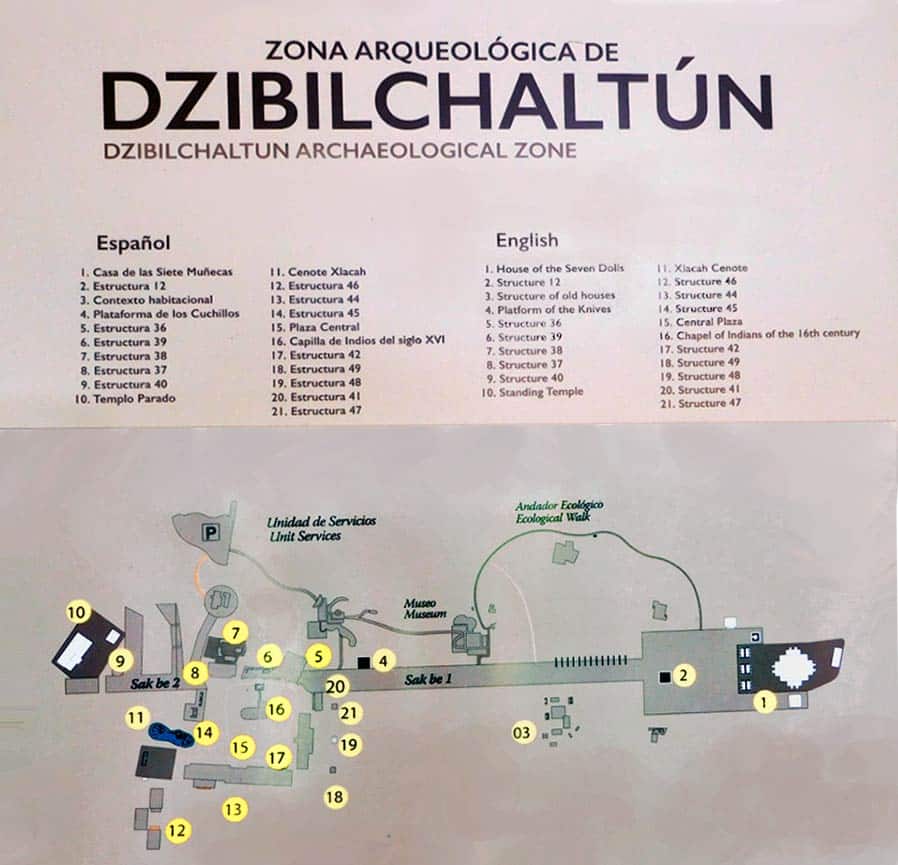
How long should I allow when visiting Dzibilchaltun?
Like all Mayan ruins, how long you spend depends on your interests.
If you’re a tourist who likes to wander, then you should allow one to two hours.
If you are keen on Mayan history and have visited other archaeological sites or you are using a guide, you will need two to three hours.
The Mayan People’s Museum (previously known as the Dzibilchaltun Museum) is under renovation and closed. The new museum will have some amazing exhibits according to the reports. When that opens, you will probably need to add another 30 minutes to an hour!
Despite what many blogs say, the cenote has been ‘temporarily’ closed for over 2 years – and doesn’t look like opening soon. So do not plan to spend any time swimming in it.
What can I see when visiting the Dzibilchaltun Mayan Ruins?
Dzibilchaltun is a modern Mayan name that means “writing on flat stones.” This is due to the number of stelae or stones with glyphic writing carved on them. A recently discovered deer bone had the original name of the city – Ch’iy Chan Ti’ Ho’a – engraved on it.
The current archaeological site is about 7 square miles (19 square km). Archaeologists think the area may contain as many as 8,400 buildings! For good reason, many consider Dzibilchaltún to be the largest pre-Hispanic city in all of Mesoamerica.
The buildings you can see at the archaeological site date from about 700 CE to 1500 CE.
The major structures and temples at Dzibilchaltun were painted with various bright colors. Red was the most common. The Temple of the Dolls was painted white.
Remnants of the paint and colors are still visible in some corners of the ruins.
Surfaced with white limestone, the sacbe (raised roads) were understandably called “white roads”.
Temple of the Seven Dolls
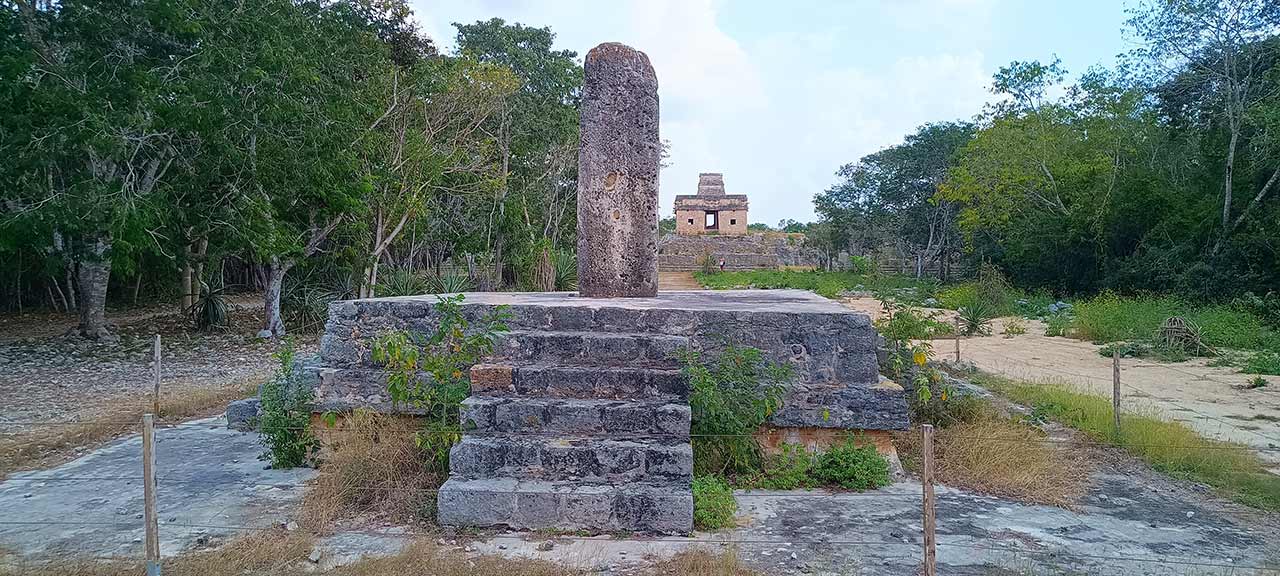
The Temple of the Dolls is the most iconic of the Mayan ruins at the Dzibilchaltun archaeological site. The temple is also known as the Temple of the Sun or just the Temple of the Dolls. It is the one that always appears online in searches for the site.
It was first seen in 1941 under the remains of a bigger temple called Structure 1. Structure 1 was really just a pile of old rocks and rubble. However, one corner had collapsed to reveal the intriguing possibility of a different structure underneath (later called Structure 1-Sub).
In the 1950s, after deciding that Structure 1 was beyond restoration, work started to uncover Structure 1- Sub. Eventually, the removal of about 7,000 tons of rocks and rubble revealed what we now call the Temple of the Seven Dolls
Building of Structure 1 – Sub or the Temple of the Seven Dolls probably took place between 650 CE and 800 CE.
Archaeologists assign a date between 1300 CE to 1500 CE for the building of Structure 1. There are still some remnants of the original Structure 1 visible on the east and north (front and right) sides of the Temple.
Building a new temple on top of an old one was common practice in the Mayan world, so this was not unusual. As the archaeologists started the excavate the floor of Structure 1 – sub, they found evidence of an even older temple under it. During these excavations, they found the seven dolls that gave the temple its name.
The unusual design of the Temple of the Seven Dolls
Built on a square pyramid base, the Temple of the Seven Dolls has nine narrow steps leading up to the temple. On the roof of the temple is a short tower. In front of the temple is a stela. One unique feature of this temple is it was originally painted white, while most of the buildings at Dzibilchaltun used red as the main color.
The temple itself is square, with openings on each of the four sides and two small square windows on the front and back (east and west sides) of the building. On the front, above the door, is a large frieze of masks and other decorations. In total, there are eight masks rain of the rain god Chaac on the temple, along with various other carvings such as serpents, sea animals, and feathers.
The construction of the temple differs significantly from other buildings at the Dzibilchaltun Mayan ruins. The stones are roughly hewn and mud was often used rather than mortar. The walls are not smooth and are thicker than normally found in Mayan buildings of a similar size.
The Temple of the Seven Dolls is about half a mile from the rest of the ruins open to the public. You have to walk along the old road, called sacbe by the Mayans. A sacbe is a raised road made of limestone, giving it a white coloration.
It’s a long walk in the sun, so wear a hat! The road is not bad but if you have thin-soled shoes, the stones might be uncomfortable. There is a sandy path running parallel to the sacbe under the trees. It’s not just kinder to your feet, it will give you shade from the sun!
The Vernal Equinox at Dzibilchaltun and the mask of fire!
One outstanding feature is the alignment of the temple. At the vernal equinox (March and September), the doorways at the front and back line up at sunrise to create a spectacular sight.
The sun shines directly through both doors and the two windows. From a distance, this gives (to some) the appearance of a fiery mask of the sun. The timing of the spectacle had great significance to the Mayans.
Corn was (and to a great extent still is) the main staple of the Mayan diet. March sees the start of the rainy season and the start of the ground preparation and growing season for corn. September is the start of the dry season and time for harvesting.
Different authorities assign different gods to the temple based on the equinox events. To some, this is a sign from the agriculture or corn god, Yum Kaax. To others, the fiery mask effect is a tribute to the sun god, Ah Kin.
However, there are no carvings or archaeological features to show the Mayans observed the equinox effect in the way some portray it today. It’s still cool to watch, though!
To enable visitors to see the sunrise, the site is open at 5 am on the appropriate days.
The Seven Dolls of Dzibilchaltun
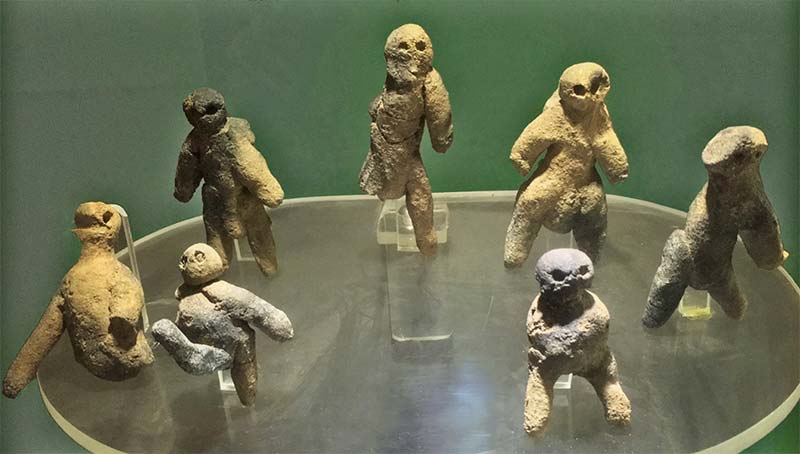
The seven dolls discovered that give the Temple of the Seven Dolls its English name are an enigma. Just to be clear, though, they are not kids’ dolls. Archaeologists are certain they have some religious or spiritual meaning.
The seven dolls are small, crudely made ceramic figurines, and poorly fired. There are six females and one male, all with oversized genitals. The ratio of females to males is unusual – is it significant? The seven dolls also exhibit possible deformities and effects of disease. Why?
Archaeologists differ in their opinion as to the purpose of these dolls. Were they used for curing disease? Agricultural sacrifices? Fertility? Offering to water gods in a time of drought? You choose!
The priests buried them in a hole about 3 feet (1m) deep that remained open and unfilled. Were they left that way, to allow ‘spirits’ associated with the sacrifice to remain free or to communicate with the human world above?
One thing to bear in mind is that they are not really part of the visible Temple of the Seven Dolls. The new temple (Structure 1) was constructed between 1250CE and 1500CE. The priests buried the seven dolls buried during the time of the newer temple.
The Franciscan Chapel at Dzibilchaltún
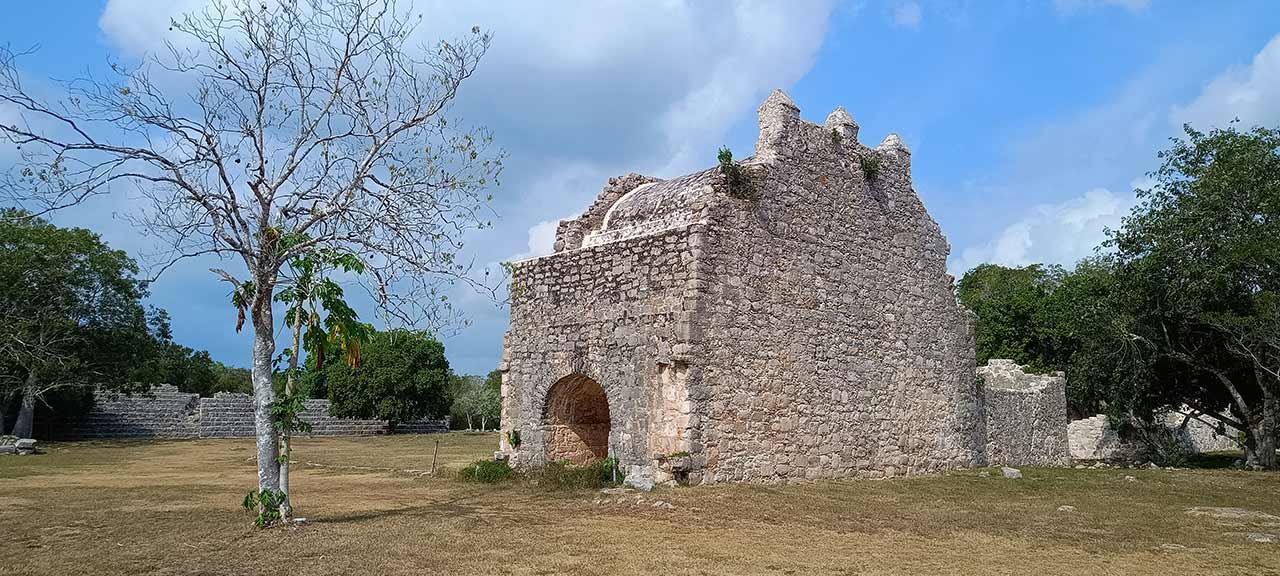
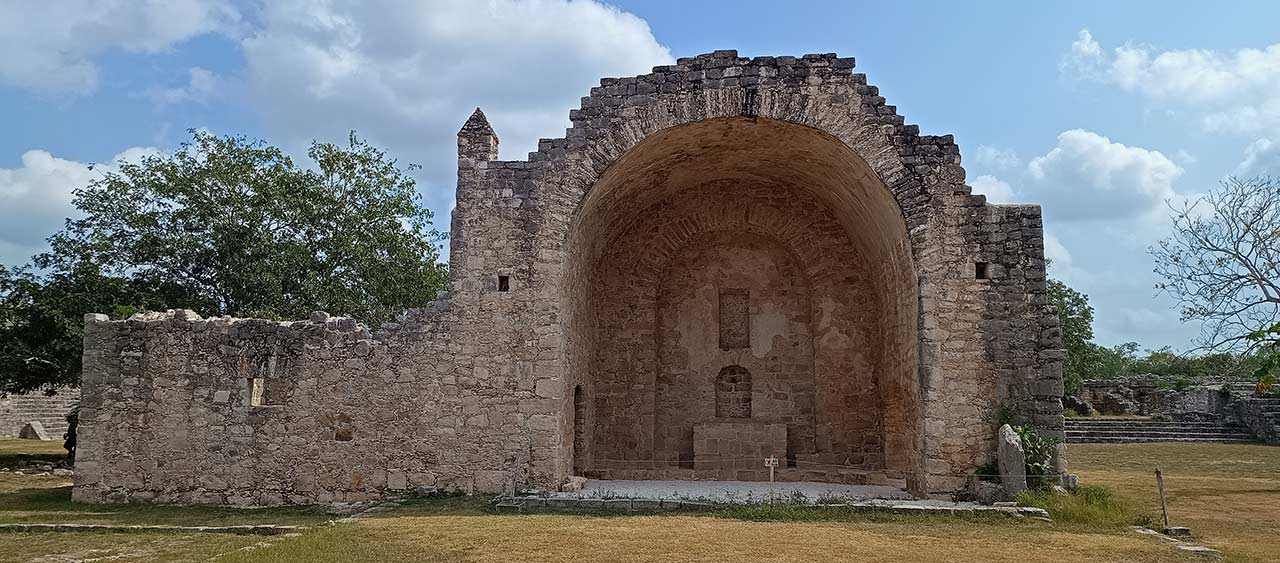
When the Spaniards arrived in the early 1500s, they found a sufficient number of people in and around Dzibilchaltún to warrant the building of a chapel. This was part of their efforts to convert the local population to Catholicism and to overthrow the ‘pagan practices’ they found.
The building of this open chapel was completed in the Central Plaza around 1592. The nearby small friars’ house has the date 1593 inscribed on it. The chapel continued in use until the 17th Century. Interestingly, this chapel is now thought to be one of the oldest churches in all of the Americas!
Built several centuries after the Mayan buildings, the chapel remained standing until modern times. It was this building that drew Wyllys Andrews IV to Dzibilchaltún in 1941 and led to the interest in the Mayan site by archaeologists.
The original chapel had an open front. This was based on the observation that the Mayans worshipped in the open air and not inside religious buildings like cathedrals.
To provide cover from the rain and sun, a thatched but open nave extension was built out from the chapel.
When it was first visited by Wyllys Andrews IV in 1941, the faded painting of a bishop and the archangel on a horse was still visible on the back wall.
Also near the chapel is a large open area opposite the palace. The acoustics are incredible and if you stand in the middle of the open area and clap or make any noise, you can hear a resounding echo.
The Central Plaza of the Dzibilchaltun Mayan ruins
This is the most thoroughly excavated and explored of the three main plazas at the Dzibilchaltun Mayan ruins. It is large at 437 feet (133 m) by 343 feet (105 m). It is also the plaza that you arrive at on entry and the one you will spend most time at. The floor was originally completely stuccoed but that has mostly gone and is now mainly grass and stone.
The Franciscan Chapel is in the middle of the Central Plaza.
The following buildings are among those to enjoy at the Central Plaza:
Structure 36
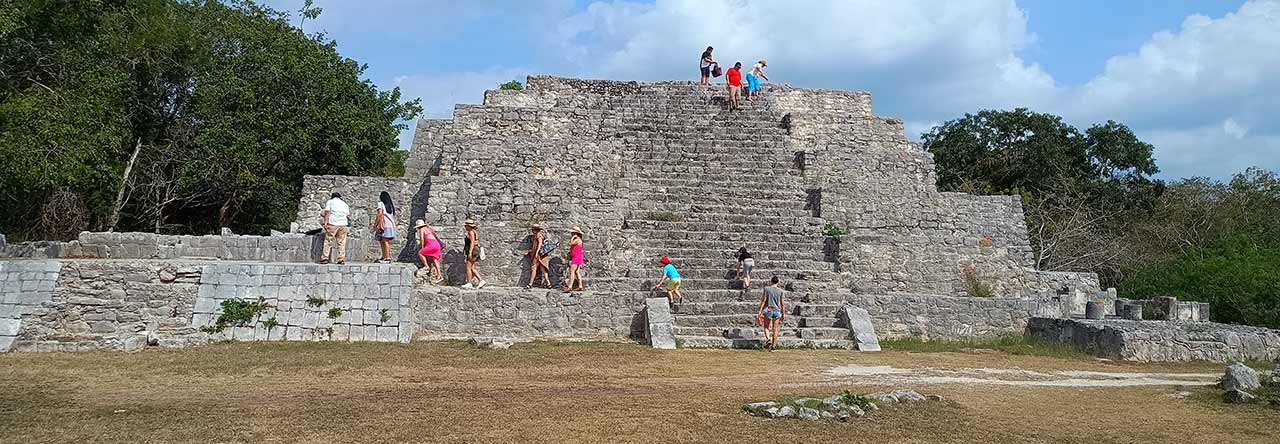
Great for climbing, Structure 36 is a reasonably sized, stepped pyramid, with 4 levels. Built into the base are three broken but carved stela that probably pre-date the pyramid by 100 years or so.
Structure 37
Located west of Structure 36, this is another lowish platform with ten steps to the top. Not much is known about this structure.
Structure 42
Structure 42 is on the east side of the plaza. The building is a low platform, about 200 feet (67 m) long, with 5 to 7 steps, depending on where you start. Behind the platform are several multi-roomed buildings.
Archaeologists speculate this was a dwelling place for the elite. The building also contains the burial site from the 9th Century of a ruler of the city, Kalom Uk’uw Chan Chac.
Structure 44
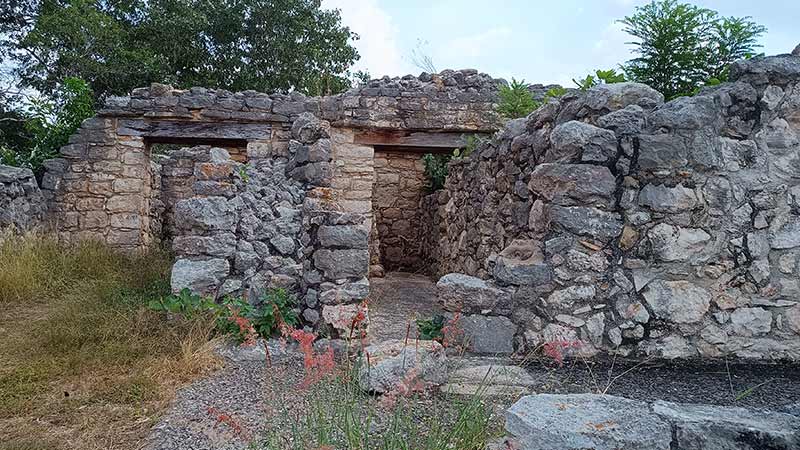
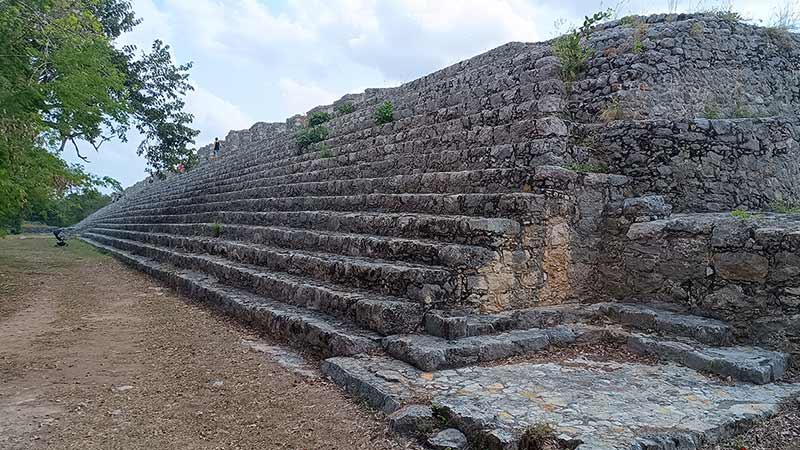
Possibly an administrative building, it is 425 feet (or 129 m) long. It’s one of the longest Mayan structures known and shares many similarities to a building at Edzna called Nohoch Na.
The stairway runs the full length of the building. It’s possible to climb to the top. I found the 14 steps taller than normal for Mayan ruins but had no problem going to the top.
At the top, you have a good view of the site one way and the jungle the other. You can also walk the full length of the building along the top, which is great!

Structure 45.
This is normally separated as Structure 45 North and Structure 45 South. Both are climbable.
Structure 45 South is a square, short pyramid, with the remains of a temple on the top. It is located next to Cenote Xlakah.
Structure 45 North stands next to Structure 45 South but is smaller. It is rectangular and contains some chambers. From the top of the stairs, you can get a good view of the Central Plaza.
South Plaza of the Dzibilchaltun Mayan ruins
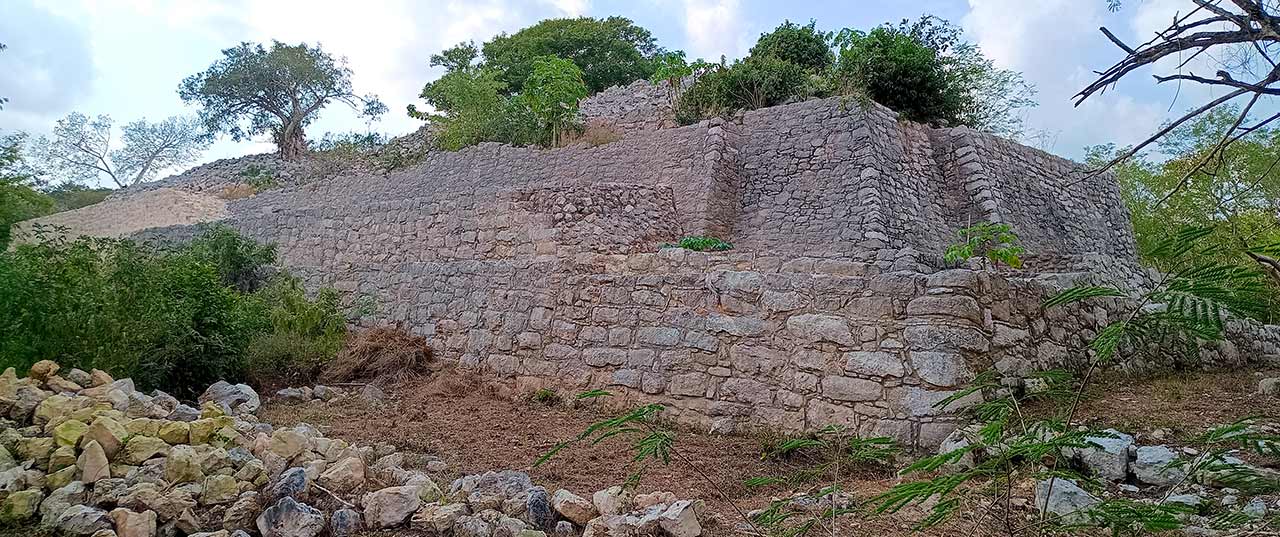
The South Plaza had some restoration some years ago. It is smaller than the Central Plaza. The measures about 380 feet (145 m) by 270 feet (82 m). Unfortunately, despite having some impressive buildings like Structure 46, it is now closed to the public. It is possible to peek through the trees and vegetation at some of the buildings if you walk past the cenote. To prevent access, the area is roped off.
Stelae – Writing on Flat Stones
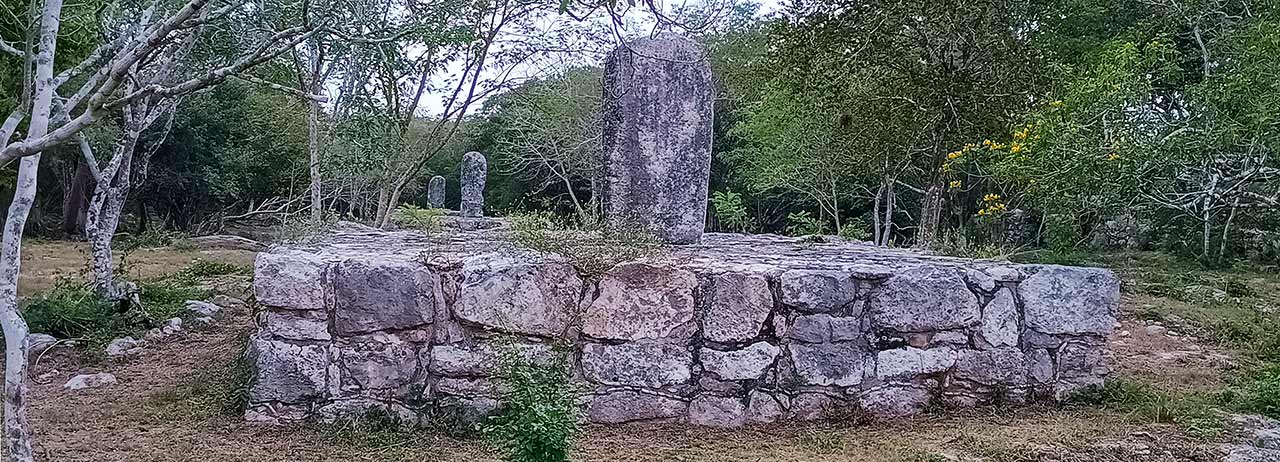
As the English translation of Dzibilchaltun is “writing on flat stones” it is hardly surprising that there are several stelae (flat obelisks) that have or had carvings on them. More than 20 stelae (or parts thereof) have so far been discovered at the Dzibilchaltun Mayan ruins.
Most have lost the carvings but a few still have enough of the glyphs to enable archaeologists to read them. Glyphs are the Mayan equivalent of Egyptian hieroglyphs. Strictly speaking, Mayans used a mix of glyphs and hieroglyphs. An oversimplification is that glyphs are letters (like we use in our writing) and hieroglyphs are pictures.
Just after you leave the Central Plaza on your way to the Temple of the Seven Dolls, you pass three stelae set on square platforms. Understandably, called the Stelae Plaza, the positioning of the bases (Structures 47, 48, and 49) and three stelae (Stelae 4,5, and 6) are deliberate.
According to some theories, their height and position (facing the sun) operated as a sort of solar calculator to help determine agricultural seasons.
Cenote Xlakah at Dzibilchaltun
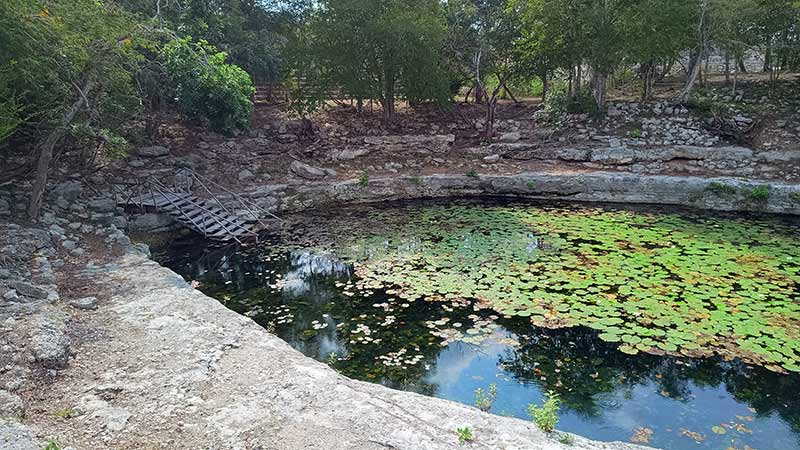
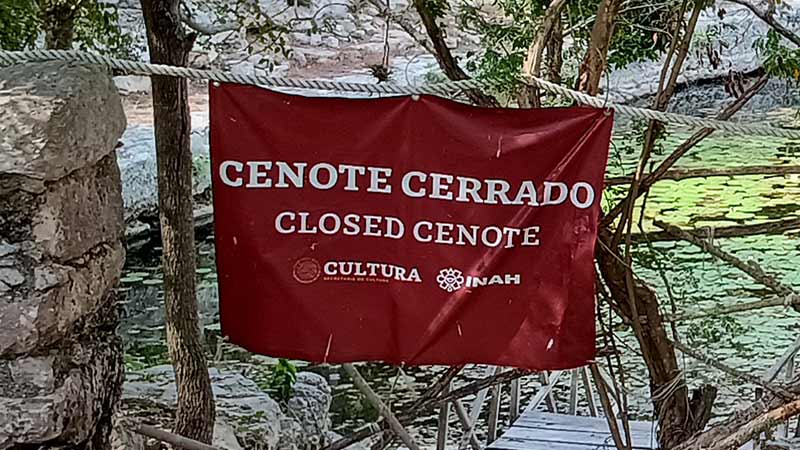
One of the key reasons for the success of Dzibilchaltún is the permanent access to fresh water provided by Cenote Xlakah. In Mayan, Xlakah means “old town”.
Cenote Xlakah is about 330 feet by 657 feet (100 m by 200m). Although shallow for a large part of its surface area, it drops to a depth of 144 feet (44 m). This makes Cenote Xlakah bigger than the Sacred Cenote of Chichen Itza.
The cenote appears to have been the center of religious activity during the Mayan period.
Divers explored Cenote Xlakah between 1956 and 1959. They uncovered a vast amount number of artifacts. For example, they found over 30,000 pieces of pottery shards, 40 intact vessels, urns, and animal bones. Parts of eight human skeletons were uncovered but the victims are thought to have drowned while collecting water rather than having been sacrificed.
When people ask if there’s a cenote near Merida, they are often told about Cenote Xlakah. If you ignore the small cenote in the car park of Costco in Centro, Merida then Cenote Xlakah is definitely the closest. Unfortunately, it’s also closed to the public.
Until recently, this was a favorite swimming place for tourists to Dzibilchaltún and residents of Merida. Closed during COVID due to fecal contamination, it doesn’t look like it’s opening soon, if at all. (Blogs that say otherwise are wrong – we have been waiting to swim in Cenote Xlakah for a couple of years!)
There are over 90 artificial wells in the area that are probably linked to the same aquifer as the cenote. If you look to the right just after you enter the archaeological site you should see a small well.
Mayan History of Dzibilchaltun

Dating back perhaps as far as early as 500 BCE, Dzibilchaltun is probably the oldest inhabited site in the Yucatan Peninsula. Still inhabited when the Spaniards arrived in the 1500s, it is one of the longest continuous inhabited places in the Mayan World.
The size of the population of the ancient city of Dzibilchaltún varies depending on which authority you believe, from 20,000 to a high of 200,000! No doubt the population fluctuated both with the weather and the politics of the region.
Dzibilchaltun was ideally placed to exploit the Mayan need for salt from the nearby salt lakes, which are still in use today. And it was close to the seaport of Xcambo for trade. The Mayan ruins at Xcambo are another tourist attraction in the area.
Although an important seaport, Xcambo, was located in a rocky mangrove area with no or limited natural fresh water. On the other hand, Dzibilchaltún was about 13 miles (22km) from Xcambo in a fertile area and next to a deep cenote that could supply fresh water year-round.
This ideal location was responsible for the success of the city. And, at some time during the period between 800 CE and 1000 CE, Dzibilchaltún acted as the regional capital.
During this same time, Dzibilchaltún had ties with the Peten Maya in what is today Guatemala. It also had links with the Usumacinta Maya near the border between Chiapas and Guatemala. Closer to home, the city had close ties with Edzna (near Campeche) and Mayapan, Chichen Itza, and Ek’ Balam in the Yucatan.
The Decline of Dzibilchaltun
As Mayapan, Chichen Itza, and Uxmal grew in political power, Dzibilchaltun’s influence waned. There is no obvious reason why the city went into decline aside from the loss of its major trading partners. By the end of the 1400s, all three major Mayan powers had fallen, either through political intrigue or from environmental problems like drought. Without the trading partners, Dzibilchaltun declined.
By the time the Spaniards arrived in the 1500s, there was still a reasonable population in the area around the city. But only a fraction remained of what was there at its peak. The buildings had started to crumble. The Spanish built a chapel in 1591 to entice the population to Catholicism. By the 1700s even the chapel was more or less abandoned as the population dropped further.
Dzibilchaltun Mayan Ruins History
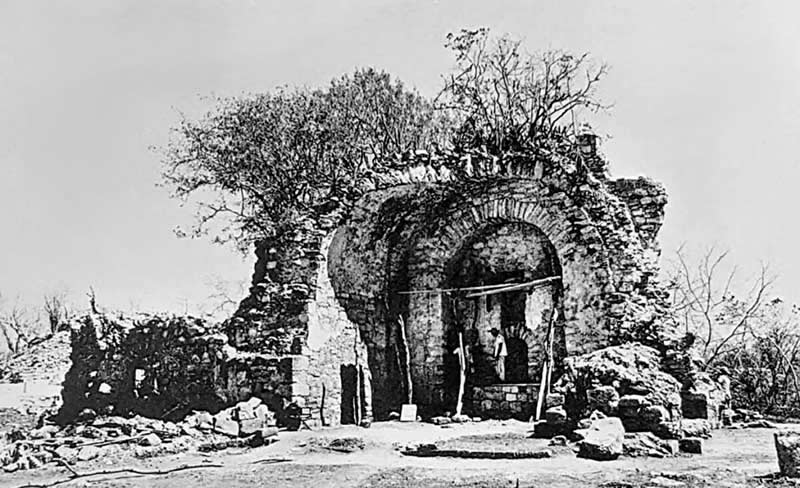
Inhabited since Mayan times, there’s no question about anyone ‘discovering’ the Dzibilchaltùn Mayan ruins! But it was only in 1941 that archaeologists started to show real interest. The first to visit were George W. Brainerd and E. Wyllys Andrews IV, a professor at Tulane University (famous for its involvement with Uxmal Mayan ruins). They were staying in Merida and heard of the Chapel ruins and came to see the chapel, nothing else.
During their visit, the local guide told them the name ‘Dzibilchaltún’ was Mayan for the ‘Place of Writing on Flat Stones’. Intrigued they started poking around the ruins, uncovering various stelae with carvings on them. World War 2 curtailed any further exploration.
Wyllys Andrews IV was able to return in 1956 to oversee a series of excavations that took place under the sponsorship of Tulane University and the National Geographic Society.
The 1960s saw further exploration of the site. In 1986, the importance of the site was better understood thanks to a new archaeological project in Dzibilchaltún. Soon after in 1987, the area became designated the Dzibilchaltún National Park. This was to protect not just the Dzibilchaltún Mayan ruins but also the flora and fauna of the area.
With over 8,400 buildings thought to be in the large area, concern has been growing over the damage caused by the encroachment from new construction work and housing in the area.
The Mayan Train and Current Improvements
With the advent of the Mayan Train, the Yucatan authorities, in conjunction with the Mexican government, are funding the Yucatan Mayan sites to make them more attractive to visitors.
Dzibilchaltun is no exception. Exploration of this huge area is ongoing. If you walk just past the cenote, you can see some of the untouched ruins through the trees. The restoration of one large pyramid is still waiting.
With the new entrance gates finished, a new Visitor Attention Center is being built. A new museum is also under construction which will cover nearly 7,000 square feet (650 sq m). This will house many of the new artifacts found in the area. This will include those uncovered by the building of the many new complexes and estates in the area, such as La Ceiba.
FAQs about Visiting Dzibilchaltùn Mayan ruins
Where are the Dzibilchaltùn Mayan ruins?
Only about 30 minutes from the center of Merida and the same from the Pier at Progreso, these Mayan ruins are perfect for a short day trip.
What is the entrance fee to Dzibilchaltùn Mayan ruins?
For tourists, the Dzibilchaltun entrance fee is a total of MXN308. That’s made up of MXN 95 for the INAH portion and MXN213 for the Government of the State of Yucatán portion).
Mexican citizens and foreign residents only pay a reduced Government fee of MXN86, making the total Dzibilchaltun entrance fee MXN181. (All fees are waived on Sundays for Mexicans and foreign residents.)
Can I climb the buildings at Dzibilchaltun Mayan ruins
Yes. Not all of the buildings but most of them. For example, you can’t climb the Temple of the Seven Dolls.
How long will a visit take?
I suggest allowing about 2 hours. You can spend more if you take a guided tour or want to spend time in the museum.
When's the best time to visit Dzibilchaltun Mayan ruins?
Normally, tours from cruise ship at Progreso come on Tuesdays and Thursday. On these days it can be a bit crowded (but there aren’t tours from every cruise ship.)
Our last trip was on a Sunday morning in January – the weather was cool (great!) and it was almost empty. But by midday, it was filling up.
Try to avoid the hottest months of May to July if possible.
What should I bring?
Cash.
Mosquito Repellent.
Good, strong shoes.
Hat.
Sunscreen.
Camera!
Are Dzibilchaltun Mayan ruins close to a Mayan Train Station?
No, the closest the Mayan Train comes to the Dzibilchaltun Mayan ruins is Teya station the other side of Merida.
That’s about 20 miles (32km), which should take about 35 minutes.
How do you pronounce Visiting Dzibilchaltùn?
It takes practice! Dzibilchaltun is pronoucned something like – Tsee-beel-chahl-toon. Tabitha cringes every time I say it!
Do you want to learn about other fascinating Mayan ruins? Click Best Mayan Ruins in the Yucatan Peninsula
If you want to find about other great day trips from Merida click: 10 best Day trips from Merida
David H
After spending months in places like Playa del Carmen and Ajijic (near Lake Chapala, Guadalajara), my family and I have been living for the past four years in the Yucatan and enjoying this fabulous part of Mexico.
I've written many travel blogs for other travel sites over the years before starting Wonky Compass. I have three books published on Amazon.
Copyright 2024 www.wonkycompass.com